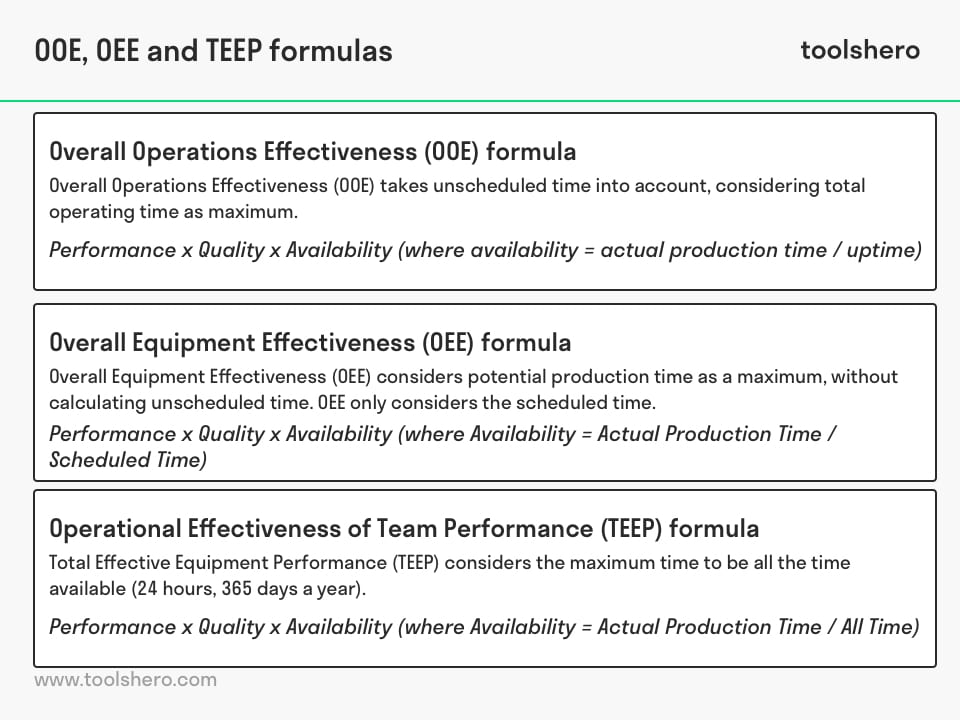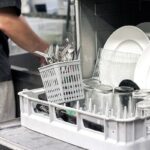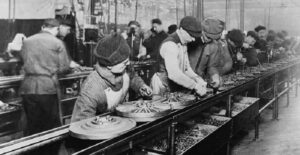Overall Operations Effectiveness (OOE)

Overall Operations Effectiveness: this article explains Overall Operations Effectiveness (OOE) in a practical way. After reading it, you will understand the basic concepts of this powerful measurement tool that will allow you to actively improve production facility performance. OOE is created from OEE basics, with the only difference that is focused on availability.
What is Overall Operations Effectiveness (OOE)?
Overall Operations Effectiveness (OOE) is a method of measuring the availability of general production lines. This method is less commonly used than other methods similar to OEE. For example, planned maintenance for machines is included in the OOE calculation, but not in the OEE calculation. That’s because machines are not productive during maintenance times. Other factors can also have an effect on OOE, such as changeover times.
In short, OOE measures the availability of all operations from the beginning to the moment it ends. In most factories it is not possible to stop production between these two moments. That’s because there are unavoidable switching times and waiting times.
Overall Operations Effectiveness (OOE) takes into account the unscheduled time, considering the total operation time as a maximum. It is calculated using the following formula:
Performance x Quality x Availability (where availability = actual production time / uptime)
Operational effectiveness defined by Michael Porter
Michael Porter explains that operational effectiveness mainly refers to performing activities better than those of competitors. Operational effectiveness includes, according to Porter, but is not limited to efficiency. It refers to a number of practices that allow a company to make better use of input by, for example, reducing defects or producing products faster.
Overall Operations Effectiveness can helpe to improve decision making in the plant
OOE’s are used to improve the decision-making process. This applies when organizations increase manufacturing capacity, as well as when they try to improve productivity and / or create flexibility and scalability in their operations.
Before a recommendation is made to investing in new equipment, the organization should consider the improvement of OEE to ensure the maximum use of the machines between the scheduled hours for operation..
As mentioned above there are other indicators that complement this industrial machine measurement system of a company, and they are:
Overall Operations Effectiveness (OOE) formula
Overall Operations Effectiveness (OOE) takes unscheduled time into account, considering total operating time as maximum.
Performance x Quality x Availability (where availability = actual production time / uptime)
Overall Equipment Effectiveness (OEE) formula
Overall Equipment Effectiveness (OEE) considers potential production time as a maximum, without calculating unscheduled time. OEE only considers the scheduled time.
Performance x Quality x Availability (where Availability = Actual Production Time / Scheduled Time)
The Operational Effectiveness of Team Performance (TEEP) formula
Total Effective Equipment Performance (TEEP) considers the maximum time to be all the time available (24 hours, 365 days a year).
Performance x Quality x Availability (where Availability = Actual Production Time / All Time)

Figure 1 – Overall Operations Effectiveness (OOE) formula
Effectiveness vs. efficiency
Operational efficiency is defined as the ratio of input to output achieved by a business by running the daily activities. Improving operational efficiency provides a better output / input ratio. An input is anything that enters the production process, such as money, people and other resources.
An output is usually money, such as turnover, margins and cash. An output can also be non-physical such as new customers, customer loyalty, speed, agility, production, quality or innovation.
Efficiency, productivity and effectiveness are often confused. Effectiveness is about how suitable something is or has been to achieve a goal. This is about actually producing the intended result.
Efficiency is about doing the best you can with the least waste of time and effort. Being effective is about doing the right things, being efficient is about doing things right.
What factors influence the Overall Operations Effectiveness (OOE)?
OOE is a measure of the performance of production lines or other assets. The effectiveness of assets can be affected by a variety of factors. Actual performance is measured as a percentage of theoretically complete performance.
Actual performance is affected by several factors causing the value to be less than 100%. Some of these factors are:
Performance
Machines or production lines may not be able to run at the same speed for all products being produced. It could be that a production line takes longer to produce a large PET bottle than a small one. Performance is measured as a percentage of the full possible performance.
Quality
Machines and production lines produce a small percentage of defective products, although Zero Defects (ZD) is pursued at all times. Quality is measured as good quality products as a percentage of the total number of products produced.
Availability
Another reason why a machine is not 100% available is defects in the machine itself, or maintenance times. Availability in this context means planned availability, so sudden defects are not included in the calculation. Other periods in which the machine does not produce are also not included, such as planned maintenance or product change. Availability is measured as a percentage of full planned availability.
A company that manages its production well scores around 85% OOE.
Tips for using Overall Operations Effectiveness (OOE)
OEE helps match equipment capacity with production requirements. If demand cannot be met and equipment is underperforming, it is reasonable to believe there is a problem with equipment effectiveness. This can be improved. If equipment works properly, but still cannot meet customer demand, there is a capacity problem.
The first important tip when using the OOE is never to copy the calculation to other machines, production lines or processes. The OEE is an average, not an aggregated sum.
OOE, like other metrics, can be used to address or even blame people for their performance, but it is primarily intended as a measure of measuring opportunities for improvement. Taking the right measures is more important in this case than blaming people. Only then will the real value of OEE, or other metrics, be exploited.
Improve Overall Operations Effectiveness (OOE)
Competition is inevitable in business. It is important to handle company assets properly and effectively, better than the competitors. This can be achieved through general operational effectiveness. This applies not only to effectiveness for equipment and production lines, but also for employees and business processes.
Create an open and effective communication climate
Improving the general operational effectiveness of a company starts with communication. Communication is essential in informing value propositions for the company and how these can be achieved through objectives and activities. By creating a collaborative and communicative environment in which there is collective reward, the entire company will work more smoothly and effectively. Every department and function within the company must be dedicated to customer satisfaction.
Communication is also important externally. Systems such as Customer Relationship Management (CRM) provide adequate communication with customers.
If various complaints about a product or service are received via this system, it is important that these complaints are forwarded to the relevant department. If a problem or bug is identified, it should be resolved as soon as possible before it becomes larger. Operational issues cost money, so the sooner they are resolved the better for the overall results.
Overall Operations Effectiveness (OOE): take product and delivery management seriously
Product and supply management must be taken to a higher level to continue to guarantee the highest quality of products and services. In some companies, a delivery manager, or delivery manager, is appointed for this reason. He or she ensures that all steps, people and processes in the entire process are synchronized and supervises the execution.
Focus on innovation and development
Training and development play an important role in improving operational effectiveness. Operational learning requires the collaboration of different employees and managers. Start by documenting and defining best practices for each department, and make it easy for employees to find information about their jobs.
In addition, it is important to perform infrastructure management properly. This ensures that company resources are organized in the most efficient way so that employees are not faced with obstacles when they are at work. An easy way to check this is to let managers measure productivity and communicate with their employees when pain points arise.
Make smart use of technology
To achieve a high degree of effectiveness, technology will likely be an important part of many companies. Ensure that all technological solutions are used that can add value to the process. Even when employees travel, it is important that they use smartphones, laptops and tablets, so that they are connected to the company wherever they are. When employees are traveling and are unable to communicate, inefficiencies can arise. Avoid this.
Technology optimization requires excellent resource management. When employees are sick or on vacation, no part of a process may be lost. In addition, all people in the company can be connected through sub-software, and understand what stage they are in the life cycle of a product or service.
Retain employees and customers
Research shows that it costs an average of five times more to attract a customer than to retain a customer. That means companies prioritize customer retention and try to prevent customer churn. Methods that help with this include using feedback channels, spending rewards for loyal customers, etc.
When it comes to retaining employees, it is important to properly assess whether the candidate is suitable for the position in the long term. Every time an employee is trained this costs a lot of resources such as time and money.
Provides employees the opportunity to continue to learn and develop in both their personal and professional lives. This stimulates employee satisfaction and reduces employee turnover. Moreover, employees are of great importance for operational effectiveness: they are the ones who can design new processes and production lines.
Now it’s your turn
What do you think? Do you recognize the explanation of the Overall Operations Effectiveness (OOE) formula? Is this, or a similar tool used in your working environment? Do you see similarities with the Overall Equipment Effectiveness0 (OEE) formula? What other methods do you know of for the management of effectiveness across the organization? Do you have anything else to add?
Share your experience and knowledge in the comments box below.
More information
- Bamber, C. J., Castka, P., Sharp, J. M., & Motara, Y. (2003). Cross‐functional team working for overall equipment effectiveness (OEE). Journal of Quality in Maintenance Engineering.
- Dal, B., Tugwell, P., & Greatbanks, R. (2000). Overall equipment effectiveness as a measure of operational improvement–a practical analysis. International Journal of Operations & Production Management.
- Garza‐Reyes, J. A., Eldridge, S., Barber, K. D., & Soriano‐Meier, H. (2010). Overall equipment effectiveness (OEE) and process capability (PC) measures. International Journal of Quality & Reliability Management.
How to cite this article:
Ospina Avendano, D. (2020). Overall Operations Effectiveness (OOE). Retrieved [insert date] from Toolshero: https://www.toolshero.com/quality-management/overall-operations-effectiveness/
Original publication date: 10/12/2020 | Last update: 08/06/2023
Add a link to this page on your website:
<a href=”https://www.toolshero.com/quality-management/overall-operations-effectiveness/”>Toolshero: Overall Operations Effectiveness (OOE)</a>












